Mountfield 1636H, 1435E user Manual

INTRODUCTION |
EN |
1 |
INTRODUCTION
Dear Customer,
Thank you for having chosen one of our products. We hope that you will get complete satisfaction from using your new machine and that it will fully meet all your expectations.
This manual has been written to help you become familiar with the machine and use it safely and efficiently. Do not forget that it is an integral part of the machine, so keep it close at hand for future reference and pass it on to the purchaser if you sell the machine.
This new lawn tractor has been designed and built in compliance with current standards, and is safe and reliable if used for cutting and collecting grass following the instructions given in this manual (proper usage). If you use the machine in any other way or ignore the instructions for safe use, maintenance and repair, it is considered "incorrect usage". In this case, the warranty is automatically voided and the Manufacturer is not held responsible for damage or injury to oneself or others.
Since we regular improve our products, you may find slight differences between your machine and the descriptions contained in this manual. Modifications can be made to the machine without notice and without the obligation to update the manual, although the essential safety and function characteristics will remain unaltered. If in doubt, do not hesitate to contact your dealer. And now enjoy your work!
AFTER-SALES SERVICE
This manual gives all the necessary instructions for using the machine and carrying out basic maintenance.
Any adjustments or maintenance operations not described in this manual must be carried out by your Dealer or a specialized Service Centre. Both have the necessary knowledge and equipment to ensure that the work is done correctly without affecting the safety of the machine.
If you wish, you can ask your dealer to prepare a maintenance programme personalised to your needs. This will help you keep your new purchase in peak performance and maintain its value over time.
2 |
|
EN |
|
TABLE OF CONTENTS |
TABLE OF CONTENTS |
|
|||
1. |
SAFETY .................................................................................................................... |
3 |
||
|
Regulations for using the machine safely |
|
||
2. |
IDENTIFICATION OF THE MACHINE AND COMPONENTS ................................ |
7 |
||
|
How to identify the machine and its main components |
|
||
3. |
UNPACKING AND ASSEMBLY .............................................................................. |
9 |
||
|
How to remove the packing and assemble loose parts |
|
||
4. |
CONTROLS AND INSTRUMENTS ....................................................................... |
12 |
||
|
Position and functions of all the controls |
|
||
5. |
HOW TO USE THE MACHINE .............................................................................. |
16 |
||
|
Instructions for working efficiently and safely |
|
||
|
5.1 |
Safety recommendations ................................................................................ |
16 |
|
|
5.2 |
Why the safety devices cut in ......................................................................... |
16 |
|
|
5.3 |
Preliminary operations before starting work ..................................................... |
17 |
|
|
5.4 |
Using the machine .......................................................................................... |
19 |
|
|
5.5 |
Using on slopes .............................................................................................. |
26 |
|
|
5.6 |
Transporting the machine ............................................................................... |
27 |
|
|
5.7 |
Lawn maintenance ........................................................................................... |
27 |
|
6. |
MAINTENANCE ..................................................................................................... |
29 |
||
|
All the information for maintaining the machine in peak efficiency |
|||
|
6.1 |
Safety recommendations ................................................................................ |
29 |
|
|
6.2 |
Programmed maintenance ............................................................................... |
29 |
|
|
6.3 |
Checks and adjustments ................................................................................ |
32 |
|
|
6.4 |
Dismantling and replacing parts ..................................................................... |
33 |
|
|
6.5 |
Information for Service Centres ..................................................................... |
35 |
|
7. |
TROUBLESHOOTING............................................................................................. |
37 |
||
|
A help in quickly solving problems |
|
||
8. |
ACCESSORIES ON REQUEST ............................................................................ |
39 |
||
|
A description of the accessories available for special requirements |
|||
9. |
SPECIFICATIONS .................................................................................................. |
40 |
||
|
A summary of the main specifications of your machine |
|
||
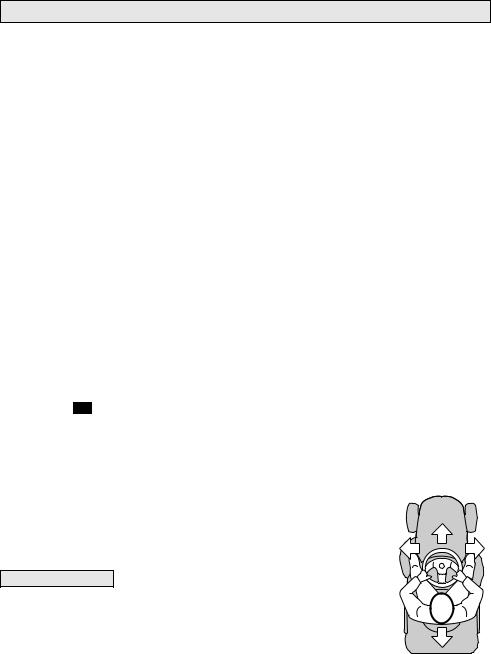
SAFETY |
EN |
3 |
1.SAFETY
1.1HOW TO READ THE MANUAL
Some paragraphs in the manual containing important information regarding safety and operation are emphasized in the following ways:
|
NOTE |
or |
IMPORTANT |
These give details or further information |
on what has already been said, in the aim to prevent damage to the machine. |
||||
|
|
|
|
|
! |
WARNING! |
Non-observance will result in the risk of injury to oneself or |
||
|
|
|||
others. |
|
|
|
|
|
|
|
|
|
! |
DANGER! |
Non-observance will result in the risk of serious injury or |
||
|
|
|||
death to oneself or others
This manual describes various versions of the machine, which mainly differ as follows:
–type of transmission: with either mechanical gear change or hydrostatic continuous speed adjustment. The models with hydrostatic transmission are identified by the word "HYDRO" on the identification label ( 2.1);
–the inclusion of components or accessories which are not widely available;
–special equipment fitted.
The symbol highlights all the differences in usage and is followed by the indication of the version to which it refers.
The symbol “ ” refers to another part of the manual where further information can be found.
NOTE |
Positions on the machine, such as “front”, |
“back”, “left” or “right” hand side, refer to the direction of forward travel.
IMPORTANT For all operations regarding the use and maintenance of the engine or the battery not described in this manual, refer to the relevant manuals which form an integral part of all the documentation supplied with the machine.

4 |
EN |
SAFETY |
1.2 GENERAL SAFETY REGULATIONS
! WARNING! Read carefully before using the machine.
A) TRAINING
1)Read the instructions carefully. Be familiar with the controls and how to use the equipment properly.
2)Never let children or people unfamiliar with these instructions use the machine. Local regulations can restrict the age of the user.
3)Never mow while people, especially children, or pets are nearby.
4)Keep in mind that the operator or user is responsible for accidents or hazards occurring to other people or their property.
5)Do not carry passengers.
6)All drivers should seek and obtain professional and practical instruction. Such instruction should emphasise:
– the need for care and concentration when working with ride-on machines;
– you cannot use the brake to regain control of a ride-on machine sliding down a slope. The main reasons for loss of control are:
–insufficient wheel grip;
–overspeeding;
–inadequate braking;
–the type of machine is unsuitable for its task;
–unawareness of the effect of ground conditions, especially slopes;
–incorrect hitching and load distribution.
B) PREPARATION
1) While mowing, always wear sturdy
footwear and long trousers. Do not operate the equipment barefoot or wearing open sandals.
2)Thoroughly inspect the area where the equipment is to be used and remove all objects which can be ejected from the machine.
3)DANGER! Petrol is highly flammable:
– store fuel in containers specifically designed for this purpose;
– refuel outdoors only and do not smoke while refuelling;
– add fuel before starting the engine.
Never remove the cap of the fuel tank or add petrol while the engine is running or when the engine is hot;
– if you spill petrol, do not start the engine and move the machine away from the area of spillage. Do not create any source of ignition until the petrol vapours have evaporated;
– put back and tighten all fuel tank and container caps securely.
4)Replace faulty silencers.
5)Before use, always inspect the machine to check that the blades, blade bolts and cutter assembly are not worn or damaged. Replace worn or damaged blades and bolts in sets to preserve balance.
6)On multi-bladed machines, remember that the rotation of one blade can cause other blades to rotate.
C) OPERATION
1)Do not start the engine in a confined space where dangerous carbon monoxide fumes can collect.
2)Mow only in daylight or good artificial light.
3)Before starting the engine, disengage the blades and shift into neutral.
4)Do not use on slopes of more than 10° (17%).
SAFETY |
EN |
5 |
5)Remember there is no such thing as a “safe” slope. Travelling on grass slopes requires particular care. To guard against overturning:
– do not stop or start suddenly when going up or downhill;
– engage the drive slowly and always keep the machine in gear, especially when travelling downhill;
– machine speeds should be kept low on slopes and during tight turns;
– tay alert for humps and hollows and other hidden hazards;
– never mow across the face of the slope.
6)Use care when pulling loads or using heavy equipment:
– use only approved drawbar hitch points;
– limit loads to those you can safely control;
– do not turn sharply. Use care when reversing;
– use counterweight(s) or wheel weights whenever advised in the instructions manual.
7)Disengage the blades before crossing surfaces other than grass.
8)Never use the machine with damaged guards, or without the safety protective devices in place.
9)Do not change the engine governor settings or overspeed the engine.
Operating the engine at excessive speed can increase the risk of personal injury.
10)Before leaving the driving seat:
–disengage the blades and lower the attachments;
–go into neutral and apply the parking brake;
–stop the engine and remove the ignition key.
11) Disengage the blades, stop the engine and remove the ignition key:
–before clearing blockages or unclog-
ging the collector channel;
–before cleaning, checking or servicing the machine;
–after striking a foreign object. Inspect the machine for damage and make repairs before restarting and operating the machine;
–If the machine starts to vibrate abnormally (check for the causes immediately). 12) Disengage the blades for transport or whenever they are not in use.
13) Stop the engine and disengage the blades:
–before refuelling;
–before removing the grass-catcher.
14) Reduce the throttle during engine run-out. If the engine is provided with a shut-off valve, cut off the fuel when you have finished mowing.
D) MAINTENANCE AND STORAGE
1)Keep all nuts, bolts and screws tight to be sure the equipment is in safe working condition.
2)Never store the equipment with petrol in the tank inside a building where fumes may reach an open flame or spark.
3)Allow the engine to cool before storing in any enclosure.
4)To reduce fire hazards, keep the engine, silencer, battery compartment and petrol storage area free of grass, leaves, or excessive grease.
5)Check the grass-catcher frequently for wear or deterioration.
6)Replace worn or damaged parts for safety purposes.
7)If the fuel tank has to be drained, this should be done outdoors.
8)On multi-bladed machines, remember that the rotation of one blade can cause other blades to rotate.
9)When the machine is to be stored or left unattended, lower the cutting deck.
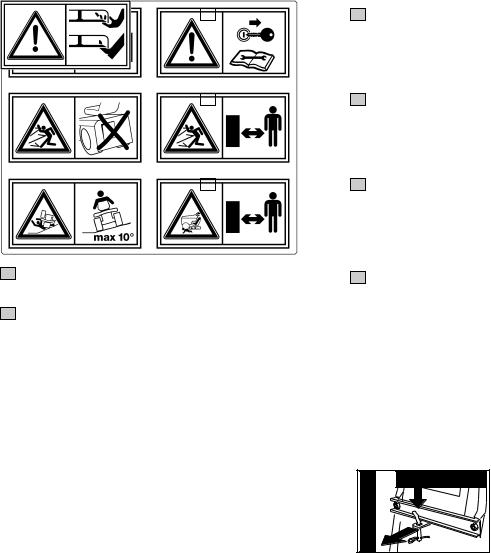
6 |
EN |
SAFETY |
1.3 SAFETY LABELS
Your machine must be used with care. This is why labels with illustrations have been placed on the machine, to remind you of the main precautions to take during use.
These labels are to be considered an integral part of the machine.
Should a label come off or become illegible, contact your dealer to replace it. Their meaning is explained below.
|
1 |
Warning: Read the instruc- |
|
|
|
1 |
|||
|
||||
tions before operating this |
||||
|
||||
machine. |
|
|||
|
|
|
|
|
2 |
Warning: Disconnect the igni- |
|
||
|
|
|||
tion key and read the instructions |
|
|||
before carrying out any repair or |
|
|||
maintenance work. |
3 |
|||
|
||||
|
|
|
|
|
3 |
Danger! Ejected objects: Do |
|
||
|
|
|||
not operate without the stone- |
|
|||
guard or grass-catcher in place. |
|
|||
|
|
|
|
|
4 |
Danger! Ejected objects: |
|
||
|
5 |
|||
|
||||
Keep bystanders away.
5Danger! Machine rollover: Do not use this machine on slopes steeper then 10°.
6Danger! Dismemberment: Make sure that children stay clear of the machine at all time when engine is running.
7Danger of cutting yourself. Blades in movement. Do not put hands or feet near or under the opening of the cutting plate.
1.4 REGULATIONS FOR TOWING
2
4
6
7
A kit for towing a small trailer is available on request.
This accessory is to be fitted following the instructions provided. When using the towing kit, do not exceed the recommended loads stated on the label and follow the safety instructions ( 1.2, C-6).
kg) |
max 245 N (25 kg) |
max 980 N (100 |
|
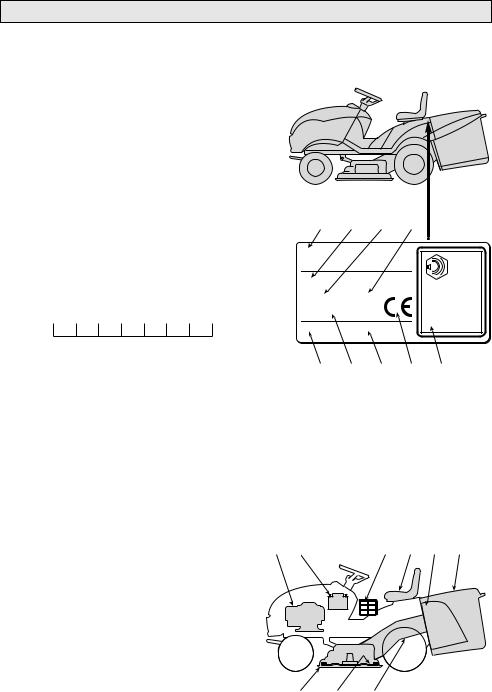
IDENTIFICATION OF THE MACHINE AND COMPONENTS |
EN |
7 |
2.IDENTIFICATION OF THE MACHINE AND COMPONENTS
2.1IDENTIFICATION OF THE MACHINE
The label located near the battery housing has the essential data of each machine.
1.Acoustic power level according to directive 2000/14/CE
2.Conformity mark according to directive 98/37/EEC
3.Year of manufacture
4.Engine speed in r.p.m (if indicated)
5.Type of machine
6.Serial number
7.Weight in kg
8.Name and address of manufacturer
9.Type of transmission (if indicated)
Write your machine’s serial number here (6)
8 |
5 |
4 |
7 |
|
|
|
|
|
LWA |
min-1 |
kg |
|
|
|
|
S/N |
|
|
dB |
|
|
|
|
|
3 |
9 |
6 |
2 |
1 |
2.2 IDENTIFICATION OF MAIN COMPONENTS
The main components of the machine have the following functions:
11. Cutting deck: this is the guard housing the rotating blades.
12.Blades: these are what cut the grass. The wings at the ends help convey the cut grass towards the collector channel.
13.Collector channel: this is the part connecting the cutting deck to the grasscatcher.
14.Grass-catcher: as well as collecting
16 |
17 |
19 |
18 |
15 |
14 |
11 |
12 |
13 |

8 |
EN |
IDENTIFICATION OF THE MACHINE AND COMPONENTS |
the grass cuttings, this is also a safety |
16 |
17 |
|
19 |
18 |
15 |
14 |
element that stops any objects drawn up |
|
||||||
|
|
|
|
|
|
|
|
by the blades from being thrown outside |
|
|
|
|
|
|
|
of the machine. |
|
|
|
|
|
|
|
15. Stone-guard or deflector (optional): |
|
|
|
|
|
|
|
this can be fitted in place of the grass- |
|
|
|
|
|
|
|
catcher and prevents objects drawn up |
|
|
|
|
|
|
|
by the blades from being thrown outside |
|
11 |
12 |
13 |
|
|
|
of the machine. |
|
|
|
|
16.Engine: this moves the blades and drives the wheels. Its specifications and regulations for use are described in a specific manual.
17.Battery: provides the energy for starting the engine. Its specifications and regulations for use are described in a specific manual.
18.Driving seat: this is where the machine operator sits. It has a sensor connected to safety devices for detecting the presence of the operator.
19.Regulation and safety labels: give reminders on the main regaulations for working safely, each of which is explained in chapter 1.
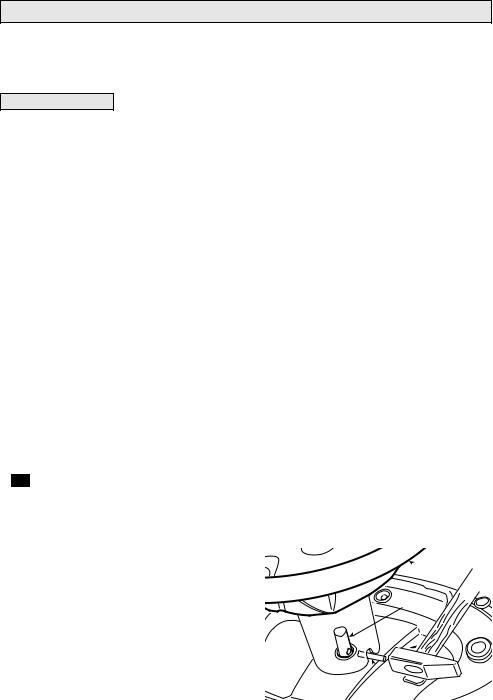
UNPACKING AND ASSEMBLY |
EN |
9 |
3. UNPACKING AND ASSEMBLY
For storage and transport purposes, some components of the machine are not installed in the factory and have to be assembled after unpacking. Follow the instructions below.
IMPORTANT The machine is supplied without engine oil or fuel. Before starting the engine, fill with oil and fuel following the instructions given in the engine manual.
3.1 UNPACKING
When unpacking the machine, take care to gather all individual parts and fittings, and do not damage the cutting deck when taking the machine off the pallet.
The packaging contains:
–the machine;
–the steering wheel;
–the seat;
–the front bumper (if provided);
–the battery;
–the grass-catcher (with instructions);
–an envelope containing:
–the instruction manuals and documents,
–nuts and bolts including a pin for locking the steering wheel,
–starter keys and a spare 10A fuse.
NOTE |
To prevent damage to the cutting deck, raise it to its maximum |
height and take utmost care when taking the machine off the pallet.
On hydrostatic drive models: to make it easier to move or take the machine off the pallet, put the transmission disengagement lever in position «B» ( 4.33).
3.2 FITTING THE STEERING WHEEL
Put the machine on a flat surface and straighten up the front wheels.
Fit the steering wheel (1) onto the protruding shaft (2) with the spokes directed towards the seat.
Line up the hole on the steering wheel hub
 1
1
2
 3
3
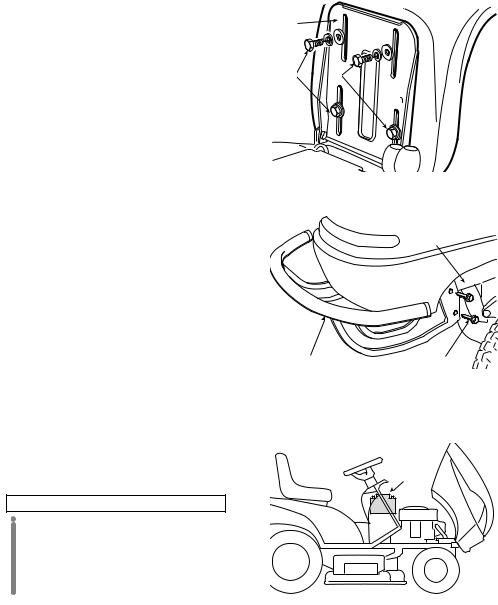
10 |
EN |
UNPACKING AND ASSEMBLY |
with the hole on the shaft and insert the pin (3) using a hammer. Make sure the end comes right through to the opposite side.
NOTE |
To avoid damage to the steering wheel, use a punch or a screw- |
|
driver of the same size as the pin when hammering it through the hole.
3.3 FITTING THE SEAT |
2 |
|
Mount the seat (1) on the plate (2) using the screws (3).
3 3
 1
1
3.4 MOUNTING THE FRONT BUMPER (if |
2 |
|
provided) |
||
|
||
Mount the front bumper (1) on the bottom of |
|
|
the frame (2) using the four screws (3). |
|
|
1 |
3 |
3.5 ACTIVATING AND CONNECTING THE BATTERY
The battery (1) is housed behind the engine and secured with an elastic tie-rod (2).
1
Acid battery:
! |
WARNING! |
|
|
|
Battery acid is cor- |
|
|
rosive and polluting. Wear protective gloves and goggles when handling the
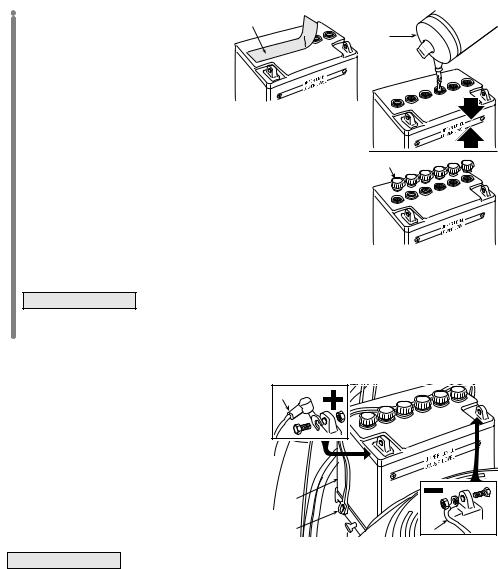
UNPACKING AND ASSEMBLY |
EN |
11 |
battery and dispose of the battery |
3 |
|
|
in accordance with the regula- |
4 |
||
|
|||
tions in force. |
|
|
|
Unfasten the elastic tie rod (2) and |
|
|
|
remove the battery and the guard |
|
|
|
(3). |
|
|
|
Pour the electrolytic solution (4) (acid not supplied: specific |
|
||
weight 1.280 or 31.5° Baumé) up to the indicated level, dis- |
|
||
tributing it evenly among the six cells. |
|
5 |
|
|
|
||
Close the six caps (5) supplied and charge the battery.
Put the battery back on the machine. The elastic tie-rod (2) should be positioned behind the battery filler caps (5).
IMPORTANT After activating the battery, always charge the battery completely with the help of your dealer, who will have all the right equipment. The battery charger is NOT able to charge the battery for the first time after activation.
First connect the red wire (6) to the positive pole (+) and then the black wire (7) to the negative pole (–), using the screws supplied as shown.
6 |
Apply silicone grease to the terminals and |
|
|
check that the protective cap for the red wire |
|
|
(6) is in place. |
1 |
|
|
2 |
7 |
IMPORTANT To prevent the safety device in the electronic circuit board from cutting in, never start the engine until the battery is fully charged!
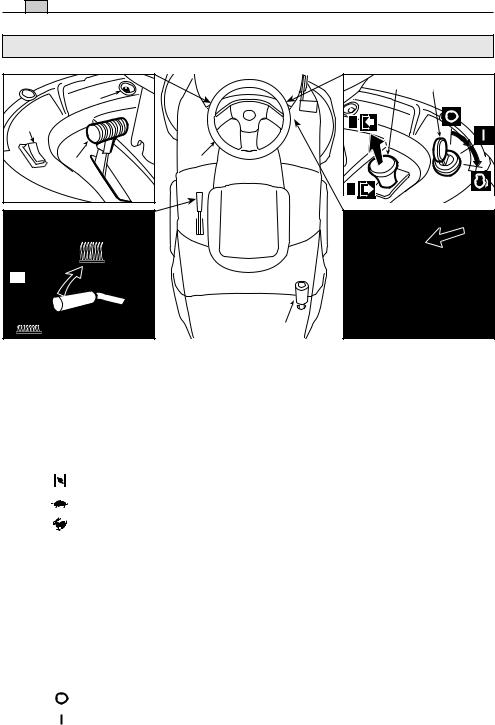
12 EN |
CONTROLS AND INSTRUMENTS |
|
4. CONTROLS AND INSTRUMENTS |
|
|
|
4.7 |
4.3 |
|
4.6 |
|
4.5 |
B |
|
|
|
|
4.2 |
4.1 |
|
|
A |
|
|
|
A |
|
|
B |
4.8 |
|
|
|
|
4.4 |
|
4.9 |
|
4.1STEERING WHEEL
Turns the front wheels.
4.2THROTTLE
This regulates the engine's r.p.m. The positions are indicated on a plate showing the following symbols:
«CHOKE» |
cold starting |
«SLOW» |
for minimum engine speed |
«FAST» |
for maximum engine speed |
–The «CHOKE» position enriches the mixture so must only be used for the time necessary when starting from cold.
–When moving from one area to another, put the lever in a position between «SLOW» and «FAST».
–When cutting, shift into «FAST».
4.3 KEY IGNITION SWITCH
This key operated control has three positions:
«OFF» |
everything is switched off; |
«ON» |
activates all parts; |
